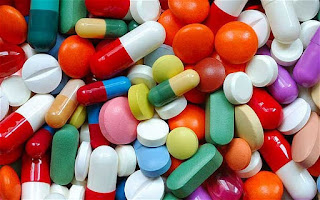Ephedrine sulfate
Trade name: Nasal
decongestant: Pretz-D
Drug classes
• Sympathomimetic drug
• Vasopressor
• Bronchodilator drug
• Nasal decongestant
Pregnancy:
(Category C) Therapeutic actions
Peripheral
effects are mediated by receptors in target organs and are due in part to the
release of norepinephrine from nerve terminals. Effects mediated by these
receptors include vasoconstriction
(increased BP, decreased nasal congestion α
receptors); cardiac stimulation (β1), and bronchodilation (β2).
Longer acting but less potent than epinephrine; also has CNS stimulant
properties.
Indications
• Treatment of hypotensive states, especially those associated
with spinal anesthesia; StokesAdams syndrome with complete heart block; CNS
stimulant in narcolepsy and depressive states; acute bronchospasm (parenteral)
• Pressor agent in hypotensive states following sympathectomy,
over dosage with ganglionicblocking agents, antiadrenergic agents, or other
drugs used for lowering BP (parenteral)
• Relief of acute bronchospasm (parenteral; epinephrine is the
preferred drug)
•
Treatment of allergic
disorders, such as bronchial asthma, and local treatment of nasal congestion in
acute coryza, vasomotor rhinitis, acute sinusitis, hay fever (oral)
•
Symptomatic relief of nasal
and nasopharyngeal mucosal congestion due to the common cold, hay fever, or
other respiratory allergies (topical)
• Adjunctive therapy of middle ear infections by decreasing
congestion around the eustachian ostia (topical)
Contraindications/cautions
• Contraindications: allergy to ephedrine, angle-closure glaucoma,
anesthesia with cyclopropane or halothane, thyrotoxicosis, diabetes,
hypertension, CV disorders, women in labor whose BP < 130/80.
• Use cautiously with angina, arrhythmias, prostatic hypertrophy,
unstable vasomotor syndrome, lactation.
Dosage
Adult
Hypotensive
episodes, allergic disorders, asthma:
25---50 mg IM (fast absorption), SC (slower absorption), or IV
(emergency administration).
Labor:
Titrate parenteral doses to maintain BP at or below 130/80.
Acute asthma:
Administer the smallest effective dose (0.25---0.5 mL or
12.5---25 mg).
Maintenance
dosage--allergic disorders, asthma:
25---50 mg PO q3---4h as necessary.
Topical
nasal decongestant:
Instill solution in each nostril q4h. Do not use longer than
3---4 consecutive days.
Pediatric:
25---100 mg/m2 IM or SC divided
into 4 to 6 doses; 3 mg/kg per day or 100 mg/m2 per day divided into
4 to 6 doses, PO, SC, or IV for bronchodilation.
Topical
nasal decongestant (> 6 y):
Instill solution in each nostril q4h. Do not
use for longer than 3---4 consecutive d. Do not use in children <6 y unless
directed by physician.
Geriatric:
More likely to experience adverse
reactions; use with caution.
Adverse effects
Systemic effects are less likely with topical
administration, but can take place, and should be considered.
• CNS: Fear, anxiety, tenseness, restlessness, headache, light-headedness,
dizziness, drowsiness, tremor, insomnia, hallucinations, psychological
disturbances, convulsions, CNS depression, weakness, blurred vision, ocular
irritation, tearing, photophobia, symptoms of paranoid schizophrenia
• GI: Nausea, vomiting, anorexia
• CV: Arrhythmias, hypertension
resulting in intracranial hemorrhage, CV collapse with hypotension,
palpitations, tachycardia, precordial pain in patients with ischemic heart disease
• GU: Constriction of renal blood
vessels and decreased urine formation
(initial parenteral administration), dysuria,
vesical sphincter spasm resulting in difficult and painful urination,
urinary retention in males with prostatism
• Local: Rebound congestion with topical nasal application
• Other: Pallor, respiratory difficulty, orofacial dystonia, sweating
Clinically
important interactions
• Drug-drug
o Severe hypertension with
MAO-inhibitors, TCAs, furazolidone o
Additive effects and increased risk of toxicity with urinary
alkalinizers o
Decreased vasopressor response with reserpine, methyldopa, urinary
acidifiers o Decreased
hypotensive action of guanethidine with ephedrine
Nursing
Considerations
• Protect solution from light; give only if clear; discard any
unused portion.
•
Monitor urine output with
parenteral administration; initially renal blood vessels may be constricted and
urine formation decreased.
• Do not use nasal decongestant for longer than 3---5 d.
• Avoid prolonged use of systemic ephedrine (a syndrome resembling
an anxiety effect may occur); temporary cessation of the drug usually reverses
this syndrome.
• Monitor CV effects carefully; patients with hypertension may
experience changes in BP because of the additional vasoconstriction. If a nasal
decongestant is needed, give pseudoephedrine.



